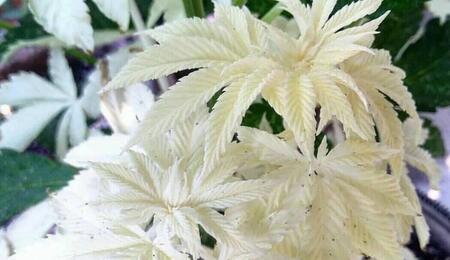The Mystery of Albino Cannabis Plants

Albino cannabis plants, also known as “white weed” is not a joke. White-appearing cannabis plants do exist as a result of a rare genetic mutation that hampers chlorophyll production. Chlorophyll is the green pigment directly involved in photosynthesis, a process which is essential for plants to live. The absence of it doesn’t sound like too much of a promise, right? Let’s find out more about albino cannabis plants.
Albinism Is a Rare Genetic Trait in Cannabis Plants
Albinism is omnipresent in nature. It’s seen in humans, animals as well as in plants. In cannabis it can result in some spectacular-looking grows, but not necessarily potent. As a genetic trait albinism is passed from parent plants, and its occurrence usually means that the plant may not have a lot of time to live after germination. The plant’s ability to convert light into energy is a vital mechanism for life. Without chlorophyll, it is a poor bet. However, albinism in cannabis is frankly rare and you don’t have to worry a bunch about it.
The Role of Chlorophyll
Chlorophyll is what gives plants their green lush. Without it, they will appear white, pale or yellowish. But this pigment is so much more! It is crucial to conduct photosynthesis, an enabling process for plant growth: sunlight is captured by the plant and conveyed into energy for key metabolic processes. The absence of chlorophyll reduces the chances of survival significantly. Should an albino plant sprouts against the odds, you may expect little yield, and wait for it - pure white buds!
Is It Only Genetics or Are There Other Factors at Play?
While genetics are the main culprit behind albinism, environmental factors can also be responsible for white coloration. Problems with the grow mediums, lights or temperature might contribute to loss of pigment and distinct white colorations in cannabis plants. But this leads us to another important point: can all these plants be called true albinos?
True Albino vs. ‘Fake’ Albino Cannabis
One specific reason for pigment loss is excess of light. Light bleaching or subjecting the plants (or parts of it) to very intense light, may result in albinism that would still not count as true albinism. True albinism is characterized by a lack of pigmentation throughout the whole plant, leading to a stark white color.
Light bleaching is usually a direct consequence of plants getting too close to the source of light. It’s caused either by fast shooting upward or improper positions of the grow lights. Usually the plant’s canopy will display the white colorations due to light bleaching. But as mentioned, despite the white appearance this would not count as real albinism. It would be what’s known as false albino; the plant does not carry the albino gene.
Is There Anything You Can Do to Help Albino Plants Grow?
Although highly unlikely to appear in your grow, albinism can be quite the challenge if you want to pursue with cultivation. What you can do to substitute for the lack of chlorophyll is provide adequate lumens through artificial light. That means, going for a special light strategy for your albino plant to give it a chance to live, and without the guarantee it will recover completely.
What you can do is:
- Use high intensity lights: albino cannabis plants would require significantly higher light intensity than pigmented plants (e.g., 3000 lux or more)
- Longer duration of light exposure: providing 12-16 hours of daily exposure might stimulate any potential for chlorophyll creation and growth.
- Light spectrum: white full-spectrum, blue and red wavelengths are all appropriate. Try them out and observe to which one your pigment-free plant is positively reacting to.
- Adjust lumens: it is recommended to go for 2000-3000 lumens per square foot during vegetation and 5000-10,000 during flowering. LED shop lights with 5,000 lumens are one option that can work.
- Closely monitoring plants: cannabis anyways requires monitoring, but with albino it is even more attention demanded. Even when lights are adjusted for albino cannabis plants grow, you have to be careful not to fry the plants with overexposure.
Can You Purposely Grow White Weed?
It’s weird why anyone would want to complicate their life with growing albino cannabis plants, but if this is what is appealing to you, then of course, yes, there is something you can do. If you want to feast your eyes with this distinct genetic trait, you can try to engineer albino cannabis plants on purpose. Through hybridization, particular traits can be eliminated or strengthened. Which certainly requires the skills of advanced breeders to successfully cultivate a strain with an albino genetic expression.
Still, it is worth remembering that there are more disadvantages than advantages from growing whitened cultivars. In addition to low potency, albino varieties may lack odor and flavor as well. Other than having a cool white plant and buds to muse to, you face the prospect of poor flower output. All while spending time and resources to adapt the environment for it, burning those lamps like a mad scientist to get just that little fruit.
What If You Want to Avoid White Weed?
You don’t have to worry too much about albinism among your cannabis girls since it’s very rare. In case you do encounter a true albino cannabis plant in your garden, you have two choices. You can go along and try if it grows by implementing the necessary light adjustments, or just quit and remove this plant from the garden as it withers (make sure you photograph it tho’).
Buying high-quality seeds with proven genetics from trusted sources will ensure that you don’t end up growing plants with any unusual features. At the end of the day, no matter how beautiful those strange albino plants might be, the average gardener will still want to see nice puffy buds on their plate.
More from Soft Secrets:






